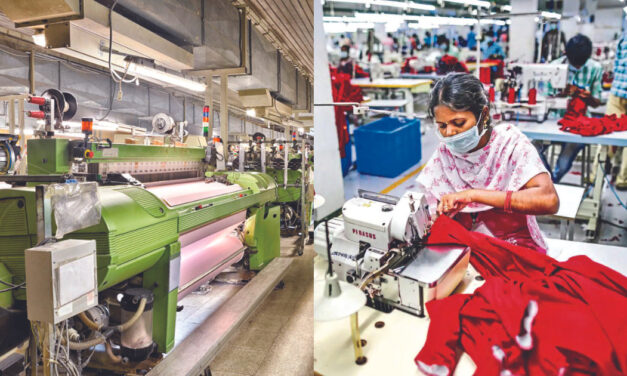Global Textiles Wrap Up 2024, Outlook 2025: Year of resilience and transformation

GLOBAL TEXTILES WRAP UP 2024, OUTLOOK 2025: YEAR OF RESILIENCE AND TRANSFORMATION
Year 2024 has seen dynamic shifts and surprising resilience in the global textile sector. Despite facing numerous challenges, the industry demonstrated an impressive ability to adapt and innovate. Here is a look at the key trends, challenges, and triumphs in the textile sector and outlook for 2025.
Factors that dominated 2024
Several factors played a crucial role in shaping the global textile landscape in 2024:
Economic slowdown: The global economic slowdown significantly impacted consumer spending, leading to decreased demand for apparel and textiles. This was particularly evident in major markets like the US and Europe.
Inflation and rising costs: Inflationary pressures and increased raw material costs, especially cotton, squeezed profit margins for textile manufacturers.
Geopolitical tensions: Ongoing geopolitical tensions and trade disputes, particularly those involving China, disrupted supply chains and created uncertainty in the market.
Sustainability concerns: Growing consumer awareness of environmental and social issues pushed sustainability to the forefront of the textile industry.
Technological advancements: Automation, AI, and 3D printing continued to transform textile manufacturing processes, improving efficiency and enabling new possibilities.
Performance: Projections vs. Reality
Pre-2024 projections anticipated moderate growth for the textile sector. However, the reality was more complex. While some segments, such as technical textiles and sustainable fashion, experienced growth, overall performance was subdued due to the numerous challenges.
Region | Projected growth (%) | Actual growth (%) |
Asia Pacific | 4.5 | 3.8 |
North America | 2 | 1.2 |
Europe | 1.5 | 0.8 |
Global | 3.2 | 2.5 |
Source: Statista, 2024 estimates
Winners and Losers
Winners: Countries like Bangladesh and Vietnam, with their competitive labor costs and established manufacturing infrastructure, continued to attract investment and expand their market share. The domestic textile industry in India also showed resilience, driven by strong government support and a focus on technical textiles.
Losers: Countries heavily reliant on exports to Western markets, such as China and some European nations, faced difficulties due to reduced demand and increased competition.
Bangladesh's resilient growth
Despite global headwinds, Bangladesh's textile industry managed to maintain steady growth in 2024. Factors contributing to this success include:
Competitive labor costs: Bangladesh continues to offer some of the lowest labor costs in the world, making it an attractive destination for textile manufacturing.
Government support: The Bangladeshi government has implemented various policies to support the textile industry, including tax incentives and infrastructure development.
Focus on sustainability: Many Bangladeshi factories have invested in sustainable practices, appealing to environmentally conscious brands and consumers.
Outlook for 2025, change drivers
Looking ahead, several factors are expected to drive change in the global textile sector in 2025:
Shifting consumer preferences: Consumers are increasingly seeking personalized, sustainable, and ethically produced clothing. This trend will compel brands and manufacturers to adapt their offerings.
Technological disruption: Further advancements in automation, AI, and data analytics will continue to reshape textile manufacturing, leading to increased efficiency and customization.
Circular economy: The concept of a circular economy, where resources are reused and waste is minimized, is gaining traction in the textile industry. This will drive innovation in recycling, upcycling, and sustainable material development.
Regionalization of supply chains: The pandemic and geopolitical tensions have exposed the vulnerabilities of global supply chains. Companies are increasingly seeking to diversify their sourcing and manufacturing operations, leading to a more regionalized approach.
Projections and opportunities
Despite the challenges, the global textile market is projected to grow steadily in 2025. The table outlines projected growth rates for key segments:
Segment | Projected Growth (%) |
Apparel | 3.5 |
Technical Textiles | 6.2 |
Home Textiles | 4.8 |
Source: Global Textile Market Outlook, 2025
Opportunities
Sustainable and ethical fashion: Brands and manufacturers that prioritize sustainability and ethical practices are well-positioned for growth.
Technical textiles: The demand for technical textiles, used in various industries like healthcare, automotive, and construction, is expected to surge.
E-commerce and digitalization: The rise of e-commerce and digital platforms presents new opportunities for textile businesses to reach consumers directly and expand their market reach.
The global textile sector in 2024 has been a testament of resilience and adaptability. Despite facing economic headwinds and geopolitical challenges, the industry has continued to innovate and evolve. Looking ahead, the sector is poised for further transformation, driven by shifting consumer preferences, technological advancements, and a growing focus on sustainability. By embracing these changes and seizing the opportunities that lie ahead, the textile industry can ensure its continued growth and success in the years to come.
By Fashionating World
https://www.fashionatingworld.com/new1-2/global-textiles-wrap-up-2024-outlook-2025-year-of-resilience-and-transformation
